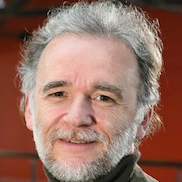Energy-constrained and sustainable deep learning
A renewable energy hub is an energy system element that coordinates renewable energy harvesting and its internal usage and that its connectivity with the energy system via a multi-energy infrastructure. The development of a renewable energy hub implies therefore the definition of the sizes of the energy harvesting, the energy conversion to services and products and energy management equipments and the corresponding costs in order to define the flows of exchange with the main system. In the talk, we will discuss how different types of data production by data centers can contribute in renewable energy hubs at different scales : building, districts,.... We will describe synergies that results from the systemic integration of the different types of data production services with other energy services like heating, cooling, living and mobility in a multi-energy approach in a urban system.

After a graduation in chemical engineering from the University of Liège, I have obtained a Ph. D. from the University of Liège in the LASSC laboratory of Prof. Kalitventzeff (former president of the European working party on computer aided process engineering). This laboratory was one of the pioneering laboratory in the field of Computer Aided Process Engineering. In the group of Professor Kalitventzeff, I have worked on the development and the applications of data reconciliation, process modelling and optimisation techniques in the chemical process industry, my experience ranges from nuclear power stations to chemical plants. In the LASSC, I have been responsible from the developments in the field of rational use of energy in the industry. My first research topic has been the methodological development of process integration techniques, combining the use of pinch based methods and of mathematical programming: e.g. for the design of multiperiod heat exchanger networks or Mixed integer non linear programming techniques for the optimal management of utility systems. Fronted with applications in the industry, my work then mainly concentrated on the optimal integration of utility systems considering not only the energy requirements but the cost of the energy requirements and the energy conversion systems.
I developed methods for analysing and integrating the utility system, the steam networks, combustion (including waste fuel), gas turbines or other advanced energy conversion systems (cogeneration, refrigeration and heat). The techniques applied uses operation research tools like mixed integer linear programming and exergy analysis. In order to evaluate the results of the utility integration, a new graphical method for representing the integration of the utility systems has been developed. By the use of MILP techniques, the method developed for the utility integration has been extended to handled site scale problems, to incorporate environmental constraints and reduce the water usage. This method (the Effect Modelling and Optimisation method) has been successfully applied to the chemical plants industry, the pulp and paper industry and the power plant. Instead of focusing on academic problems, I mainly developed my research based on industrial applications that lead to valuable and applicable patented results. Recently the methods developed have been extended to realise the thermoeconomic optimisation of integrated systems like fuel cells. My present R&D work concerns the application of multi-objective optimisation strategies in the design of processes and integrated energy conversion systems. Since 2001, I’m working in the Industrial Energy Systems Laboratory (LENI) of Ecole Polytechnique fédérale de Lausanne (EPFL) where I’m leading the R&D activities in the field of Computer Aided Analysis and Design of Industrial Energy Systems with a major focus on sustainable energy conversion system development using thermo-economic optimisation methodologies. A part from the application and the development of process integration techniques, that remains my major field of expertise, the applications concern :
- Rational use of water and energy in Industrial processes and industrial production sites : projects with NESTLE, EDF, VEOLIA and Borregaard (pulp and paper).
- Energy conversion and process design : biofuels from waste biomass (with GASNAT, EGO and PSI), water dessalination and waste water treatment plant (VEOLIA), power plant design (ALSTOM), Energy conversion from geothermal sources (BFE).
- Integrated energy systems in urban areas : together with SCANE and SIG (GE) and IEA annexe 42 for micro-cogeneration systems.
I as well contributed to the definition of the 2000 Watt society and to studies concerning the emergence of green technologies on the market in the frame of the Alliance for Global Sustainability.